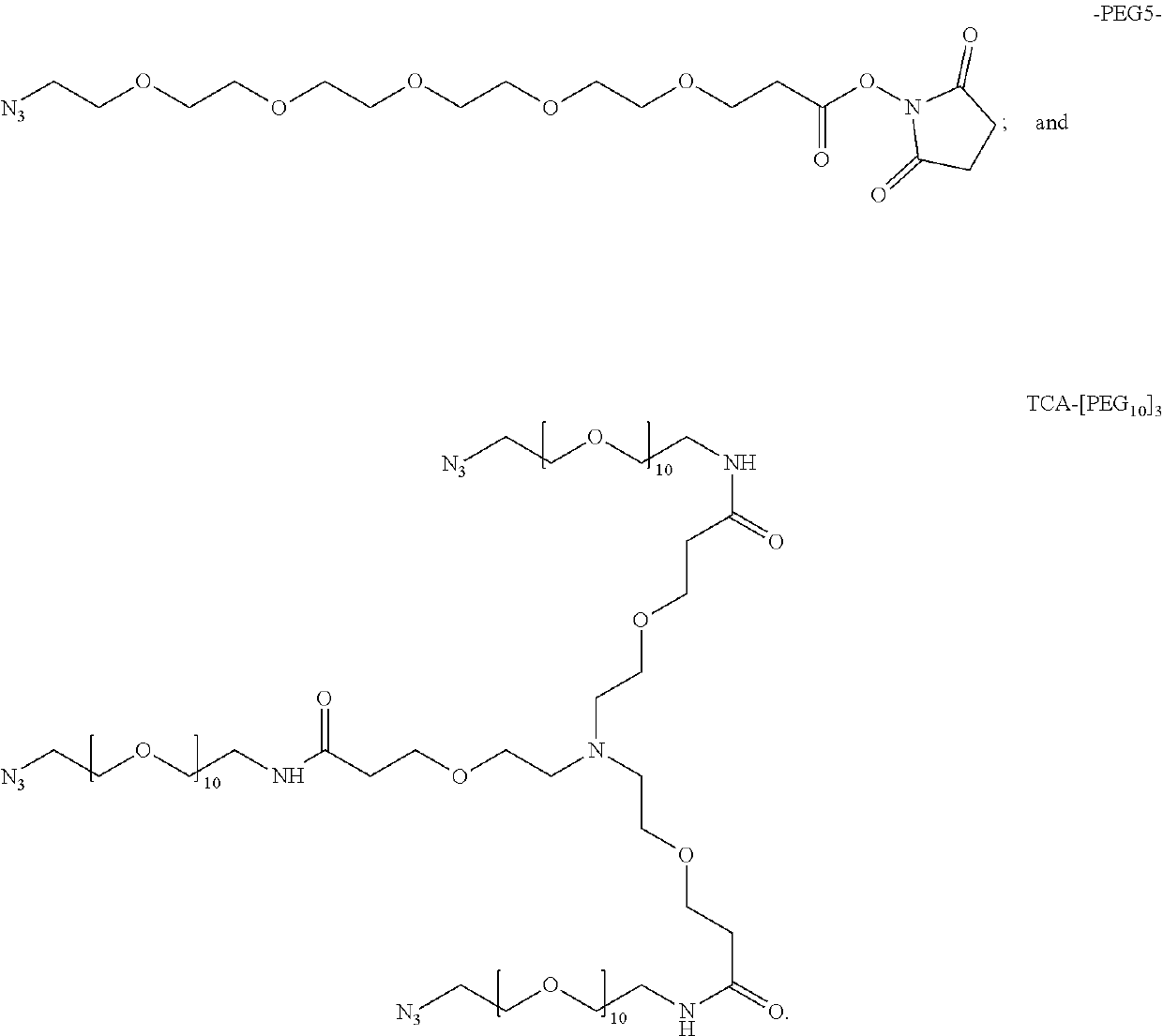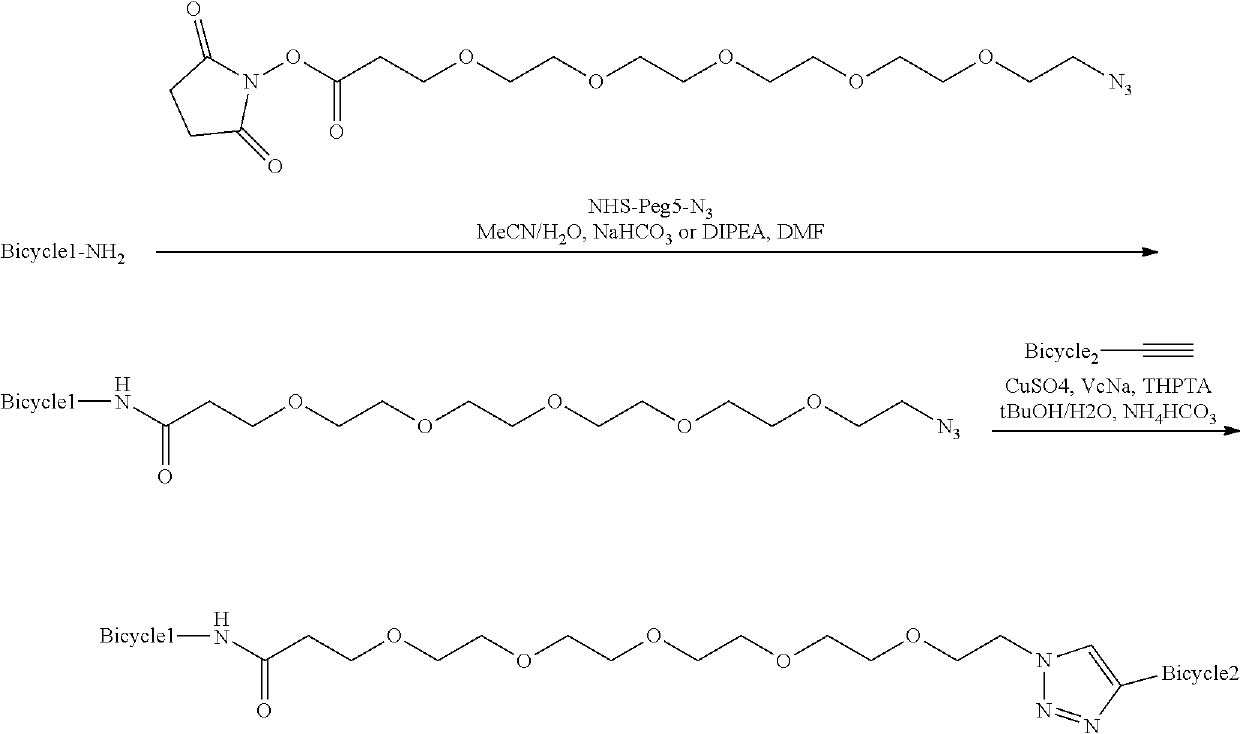Heterotandem bicyclic peptide complexes
a bicyclic peptide and complex technology, applied in the direction of peptides, drug compositions, peptides/protein ingredients, etc., can solve the problem of reducing the conformational flexibility of cyclic structures, and achieve the effect of preventing, suppressing or treating cancer
- Summary
- Abstract
- Description
- Claims
- Application Information
AI Technical Summary
Benefits of technology
Problems solved by technology
Method used
Image
Examples
example 1
of BCY12375
[0157]
[0158]Procedure for Preparation of Palmitic Acid—PEG10-N3
[0159]A mixture of Palmitic acid (100.0 mg, 282.89 μmol, 1.0 eq.), compound 2 (150.0 mg, 284.84 μmol, 1.0 eq.), and DIEA (74.5 mg, 574.11 μmol, 100.0 μL, 2.0 eq.) was dissolved in DMF (2 mL). The reaction mixture was stirred at 30° C. for 2 hr. LC-MS showed compound 1 was consumed completely and one main peak with desired m / z (MW: 765.03, observed m / z: 765.22) was detected. The reaction mixture was concentrated under reduced pressure to remove solvent and produced a residue. The residue was then purified by prep-HPLC (neutral condition). Palmitic acid—PEG10-N3 (79.0 mg, 99.41 μmol, 35.14% yield, 96.27% purity) was obtained as a white solid.
[0160]Procedure for Preparation of Palmitic Acid-PEG10-BCY12023
[0161]A mixture of compound 3 (50.0 mg, 22.07 μmol, 1.0 eq.), compound 2 (17.0 mg, 22.22 μmol, 1.0 eq.), and THPTA (10.0 mg, 23.02 μmol, 1.0 eq.) was dissolved in t-BuOH / H2O (1:1, 1 mL, pre-degassed and purged wi...
example 2
of BCY12021
[0166]
[0167]Procedure for Preparation of Palmitic Acid—PEG10-BCY11144
[0168]A mixture of compound 3 (160.0 mg, 69.45 μmol, 1.0 eq.), compound 4 (56.0 mg, 72.20 μmol, 1.0 eq.), and THPTA (35.0 mg, 80.55 μmol, 1.1 eq.) was dissolved in t-BuOH / H2O (1:1, 2 mL, pre-degassed and purged with N2 for 3 times), and then CuSO4 (0.4 M, 56.0 μL, 1.0 eq.) and VcNa (30.0 mg, 151.43 μmol, 2.2 eq.) were added under N2. The pH of this solution was adjusted to 8 by dropwise addition of 0.2 M NH4HCO3 (in 1:1 t-BuOH / H2O), and the solution turned to light yellow. The reaction mixture was stirred at 40° C. for 16 hr under N2 atmosphere. LC-MS showed one main peak with desired m / z (calculated MW: 3068.70, observed m / z: 1533.81 ([M / 2+H]+), 1023.43 ([M / 3+H]+)) was detected. The reaction mixture was filtered and concentrated under reduced pressure to give a residue. The crude product was purified by prep-HPLC (TFA condition), and Palmitic acid—PEG10-BCY11144 (150.0 mg, 46.83 μmol, 67.42% yield, 95.8...
example 3
of BCY11468
[0173]
[0174]Procedure for Preparation of COM113
[0175]A mixture of compound 1 (50.0 mg, 124.4 μmol, 1.0 eq), EDCl (95.4 mg, 497.7 μmol, 4.0 eq), HOBt (55.5 mg, 410.6 μmol, 3.3 eq), and DMAP (15.2 mg, 124.4 μmol, 1.0 eq) was dissolved in 2 mL DMF, and then DIEA (134.9 mg, 1.04 mmol, 181.8 μL, 8.4 eq) was added to generate a homogenous solution. Next, compound 2 (200.0 mg, 379.8 μmol, 3.05 eq) dissolved in DMF (2 mL) was added to this solution dropwise. The reaction mixture was stirred at 30° C. for 16 hr. LC-MS showed compound 1 was consumed completely and one main peak with desired m / z (MW: 1891.19, observed m / z: 945.8600 ([M / 2+H+]) and 612.4400 ([(M-3H2O) / 3+H+])) was detected. The reaction mixture was directly purified by prep-HPLC (TFA condition), resulting in COM113 (161 mg, 85.67 μmol, 68% yield) as a yellow oil after lyophilization.
[0176]Procedure for Preparation of COM113-BCY8928
[0177]COM113 (50.0 mg, 26.44 μmol, 1.0 eq) and BCY8928 (53.0 mg, 23.9 μmol, 0.9 eq) were ...
PUM
| Property | Measurement | Unit |
|---|---|---|
| Fraction | aaaaa | aaaaa |
| Molar density | aaaaa | aaaaa |
| Dimensionless property | aaaaa | aaaaa |
Abstract
Description
Claims
Application Information
 Login to View More
Login to View More - R&D
- Intellectual Property
- Life Sciences
- Materials
- Tech Scout
- Unparalleled Data Quality
- Higher Quality Content
- 60% Fewer Hallucinations
Browse by: Latest US Patents, China's latest patents, Technical Efficacy Thesaurus, Application Domain, Technology Topic, Popular Technical Reports.
© 2025 PatSnap. All rights reserved.Legal|Privacy policy|Modern Slavery Act Transparency Statement|Sitemap|About US| Contact US: help@patsnap.com



